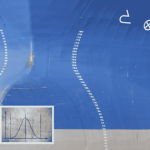The capsizing of large ships that have not suffered flooding from hull damage is virtually unheard of, but it remains a serious hazard to smaller vessels that can experience large upsetting moments under normal operating conditions. A prominent example is a fishing vessel attempting to lift a laden net over the side while already being rolled by heavy seas. In any case, a capsizing is likely to be a dynamic event rather than a static one—a consequence, for example, of the impact from a wind gust. Such an input is properly measured in terms of capsizing energy, and hence the ability of a ship to resist capsizing is measured by the energy required to rotate it to a point of vanishing stability. As noted, the resisting energy is indicated by the area enclosed by the statical stability curve; standards by which the stability of ships are judged are therefore usually based on this area. Because of the great variability of ship sizes, types, and areas of service, safety standards of all kinds are complex. The body that originates and updates these standards, the International Maritime Organization (known as IMO; an arm of the United Nations), is discussed below (see Regulation).
Damage buoyancy and stability
Building a ship that can be neither sunk nor capsized is beyond practicality, but a ship can be designed to survive moderate damage and, if sinking is inevitable, to sink slowly and without capsizing in order to maximize the survival chances of the people aboard.
The most likely cause of sinking would be a breaching of the hull envelope by collision. The consequences of the resulting flooding are minimized by subdividing of the hull into compartments by watertight bulkheads. The extent to which such bulkheads are fitted is determined by IMO standards that are based on the size and type of ship. At a minimum, ships that must have a high probability of surviving a collision (e.g., passenger ships) are built to the “one-compartment” standard, meaning that at least one compartment bounded by watertight bulkheads must be floodable without sinking the ship. A two-compartment standard is common for larger passenger-carrying ships—a measure that presumably protects the ship against a collision at the boundary between two compartments. The Titanic, the victim of the most famous sinking in the North Atlantic, was built to the two-compartment standard, but its collision with an iceberg just before midnight on April 14, 1912, ripped open at least five compartments. The Titanic could not survive such damage, but its many watertight bulkheads did retard the flooding so that the ship required two hours and forty minutes to sink.
To build a passenger ship that would survive all possible floodings is impractical, since the required fine subdivision would preclude effective use of the interior space. On the other hand, a ship carrying only liquid cargo can be subdivided quite finely, since most of its interior space is tankage. Such ships are at hazard from groundings and explosions, but their sinking from collisions is very rare.
In contrast to the Titanic, the Lusitania, a passenger liner of similar size and type, sank within a period of 20 minutes after being hit by two torpedoes on May 7, 1915. Its fault lay not in insufficient subdivision but in lack of damage stability. Longitudinal bulkheads in the vicinity of the torpedo hits limited the flooding to one side, causing the ship to heel quickly to the point where normal hull openings were submerged. As a consequence of this disaster, commercial ships are now forbidden from having internal structures that impede flooding across the hull. An exception to this regulation is the tanker, whose subdivision is fine enough that flooding of several side tanks is insufficient to capsize the ship.
One important hazard in considering damage stability is the “free surface effect.” Water that is unconfined—as flooding water that enters a damaged hull is likely to be—runs to the lowest reachable point, thus exacerbating the heel that caused the low point. Such a hazard is difficult to avoid in ships that must have interior spaces uninterrupted by bulkheads. Ferries, which usually require vehicle decks extending throughout their interiors, are an example.


